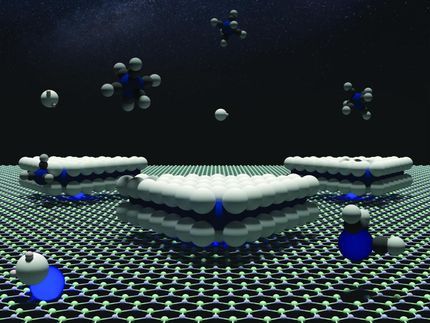New insights into promising semiconductor material
Researchers from the National University of Singapore (NUS) have established new findings on the properties of two-dimensional molybdenum disulfide (MoS2), a widely studied semiconductor of the future.
In two separate studies led by Professor Andrew Wee and Assistant Professor Andrivo Rusydi from the Department of Physics at the NUS Faculty of Science, the researchers uncovered the role of oxygen in MoS2, and a novel technique to create multiple tunable, inverted optical band gaps in the material. These novel insights deepen the understanding of the intrinsic properties of MoS2 which could potentially transform its applications in the semiconductor industry.
The studies were published Physical Review Letters and Nature Communications respectively.
MoS2 - An alternative to graphene
MoS2 is a semiconductor-like material that exhibits desirable electronic and optical properties for the development and enhancement of transistors, photodetectors and solar cells.
Prof Wee explained, "MoS2 holds great industrial importance. With an atomically thin two-dimensional structure and the presence of a 1.8eV energy band gap, MoS2 is a semiconductor that can offer broader applications than graphene which lacks a band gap."
Presence of oxygen alters the electronic and optical properties of MoS2
In the first study published in Physical Review Letters, NUS researchers conducted an in-depth analysis which revealed that the energy storage capacity or dielectric function of MoS2 can be altered using oxygen.
The team observed that MoS2 displayed a higher dielectric function when exposed to oxygen. This new knowledge shed light on how adsorption and desorption of oxygen by MoS2 can be employed to modify its electronic and optical properties to suit different applications. The study also highlights the need for adequate consideration of extrinsic factors that may affect the properties of the material in future research.
The first author of this paper is Dr Pranjal Kumar Gogoi from the Department of Physics at NUS Faculty of Science.
MoS2 can possess two tunable optical band gaps
In the second study published in Nature Communications, the team of NUS researchers discovered that as opposed to conventional semiconductors which typically have only one optical band gap, electron doping of MoS2 on gold can create two unusual optical band gaps in the material. In addition, the two optical bandgaps in MoS2 are tunable via a simple, straight forward annealing process.
The research team also identified that the tunable optical band gaps are induced by strong-charge lattice coupling as a result of the electron doping.
The first author of this second paper is Dr Xinmao Yin from the Department of Physics at NUS Faculty of Science.
The research findings from the two studies lend insights to other materials that possess similar structure with MoS2.
"MoS2 falls under a group of material known as the two-dimensional transitional metal dihalcogenides (2D-TMDs) which are of great research interest because of their potential industrial applications. The new knowledge from our studies will assist us in unlocking the possibilities of 2D-TMD-based applications such as the fabrication of 2D-TMD-based field effect transistors," said Asst Prof Rusydi.
Leveraging the findings of these studies, the researchers will apply similar studies to other 2D-TMDs and to explore different possibilities of generating new, valuable properties in 2D-TMDs that do not exist in nature.
Original publication
Pranjal Kumar Gogoi, Zhenliang Hu, Qixing Wang, Alexandra Carvalho, Daniel Schmidt, Xinmao Yin, Yung-Huang Chang, Lain-Jong Li, Chorng Haur Sow, A. H. Castro Neto, Mark B. H. Breese, Andrivo Rusydi, and Andrew T. S. Wee; "Oxygen Passivation Mediated Tunability of Trion and Excitons in MoS2"; Phys Rev. Lett.; 2017
Original publication
Pranjal Kumar Gogoi, Zhenliang Hu, Qixing Wang, Alexandra Carvalho, Daniel Schmidt, Xinmao Yin, Yung-Huang Chang, Lain-Jong Li, Chorng Haur Sow, A. H. Castro Neto, Mark B. H. Breese, Andrivo Rusydi, and Andrew T. S. Wee; "Oxygen Passivation Mediated Tunability of Trion and Excitons in MoS2"; Phys Rev. Lett.; 2017
Topics
Organizations
Other news from the department science
These products might interest you

NANOPHOX CS by Sympatec
Particle size analysis in the nano range: Analyzing high concentrations with ease
Reliable results without time-consuming sample preparation

Eclipse by Wyatt Technology
FFF-MALS system for separation and characterization of macromolecules and nanoparticles
The latest and most innovative FFF system designed for highest usability, robustness and data quality

DynaPro Plate Reader III by Wyatt Technology
Screening of biopharmaceuticals and proteins with high-throughput dynamic light scattering (DLS)
Efficiently characterize your sample quality and stability from lead discovery to quality control

Get the chemical industry in your inbox
By submitting this form you agree that LUMITOS AG will send you the newsletter(s) selected above by email. Your data will not be passed on to third parties. Your data will be stored and processed in accordance with our data protection regulations. LUMITOS may contact you by email for the purpose of advertising or market and opinion surveys. You can revoke your consent at any time without giving reasons to LUMITOS AG, Ernst-Augustin-Str. 2, 12489 Berlin, Germany or by e-mail at revoke@lumitos.com with effect for the future. In addition, each email contains a link to unsubscribe from the corresponding newsletter.





























































